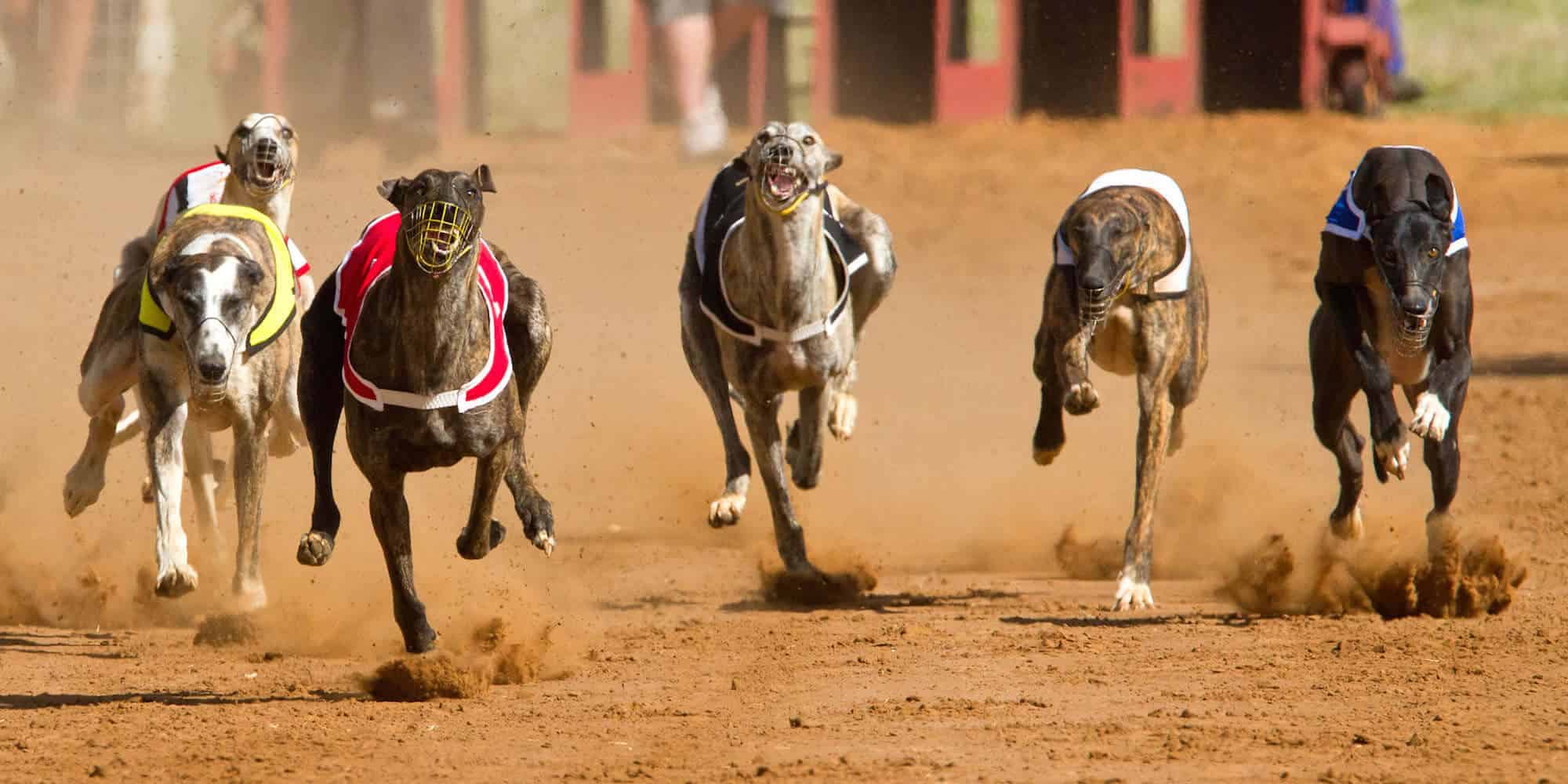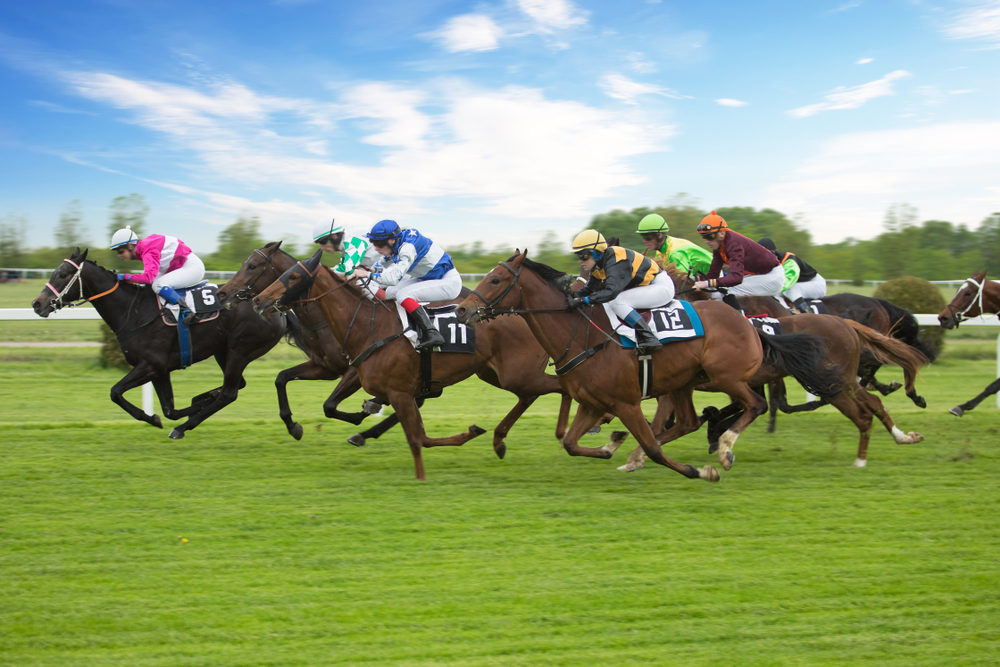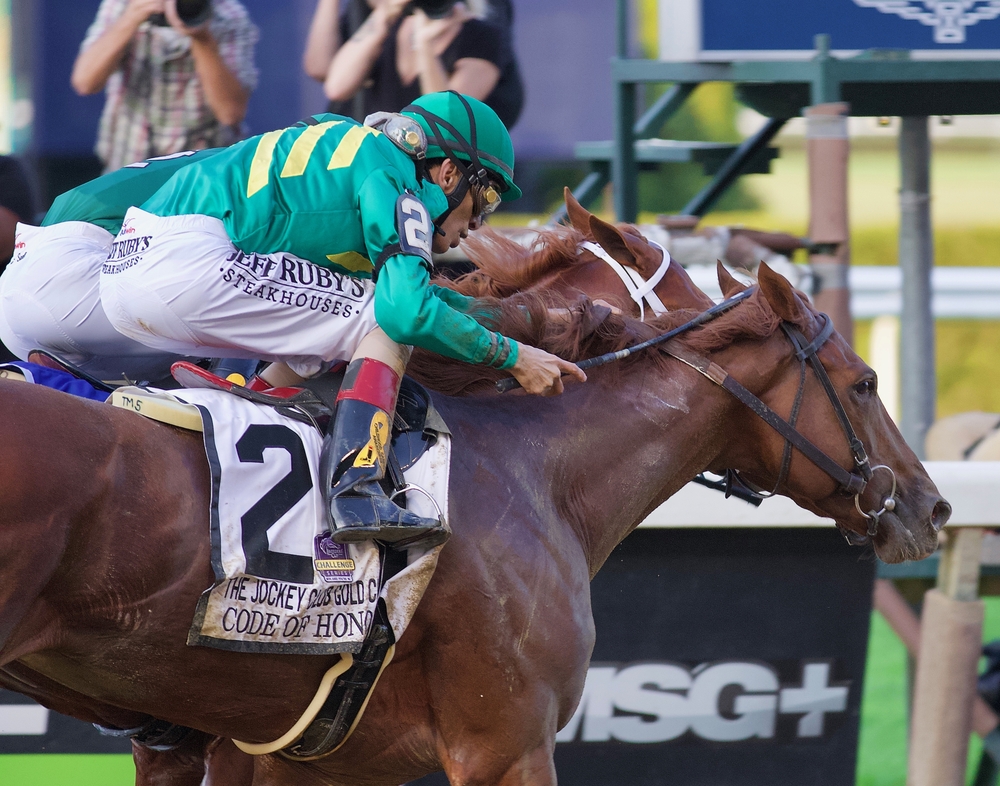Horse races take part over a variety of distances in different countries. The distances of these races are often measured in furlongs, with 1 furlong being 1/8th mile which is 220 yards or 201.1 metres. Horse races are run at distances as short as 1-furlong in the United States, whilst the Grand National is recognised as the longest official horse race in the world at 4 miles 2 furlongs and 74 yards.
How Long are Flat Races in the United Kingdom?
The answer to how long is a horse race in flat racing in the United Kingdom and Ireland is 5 furlongs, and horses that compete over this distance or six-furlongs are often referred to as sprinters. Lots of early two-year-old races also take place over the minimum distance to encourage the young horses to learn to race at speed.
The most prestigious 5-furlong races in England are the Kings Stand Stakes at Royal Ascot in June and the Nunthorpe Stakes which takes place at York’s Ebor Meeting in August. The top 5-furlong sprinters in Europe also clash in the Prix de L’Abbaye at Longchamp in October.
Group 1 opportunities over 6-furlongs include the Diamond Jubilee Stakes and the Commonwealth Cup at Royal Ascot, with the latter limited to 3-year-olds. There is then the July Cup at Newmarket and Haydock’s Sprint Cup in September.
7-furlongs tends to be a distance for specialists, as there are more opportunities for horses that can sprint or step-up in trip beyond 7-furlongs. The Jersey Stakes at Royal Ascot is one of the most prestigious races over this trip.
Horses that excel over a mile are in big demand with flat racing breeders, as this is the trip over which the first two classics of the season are run over in England and Ireland. The best English 3-year-old colts have the option to run in the English 2,000 Guineas and the Irish 2,000 Guineas. Another option for the classic generation is the St James’s Palace Stakes at Royal Ascot.
The first group 1 race over a mile for horses aged four and older is the Lockinge Stakes at Newbury. The older milers then tend to take each other in the Princess Anne Stakes at Royal Ascot. The generations then have the chance to take each other on in the Sussex Stakes at Glorious Goodwood and again at the end of the season in the Queen Elizabeth II Stakes at Ascot.
Races do take place over 9-furlongs but the next important distance on the flat is 10-furlongs as, though there are no classics in England or Ireland run over this distance, there are plenty of Group 1 Races. These include the Prince of Wales’s Stakes at Royal Ascot, the Eclipse at Sandown, the Juddmonte at York, and the Champion Stakes at Ascot.
A mile and half or 12-furlongs is the distance that the Derby and Oaks at Epsom are run over, as well as the Irish Derby and Oaks. These races are classics and the winners often go on to have lucrative careers as stallions or as broodmares. Other important races over this distance include the King George and Queen Elizabeth Diamond Stakes at Ascot. The cream of Europe’s 12-furlong horses then often clash in the Prix de l’Arc de Triomphe at Longchamp in Paris.
The fifth and final classic in England is the St Leger at Doncaster, which takes place over 1 mile 6 furlongs and 115 yards. Horses that run in this race often go onto be what is known as cup horses that run over 2-miles or further the following season. Cup horses often run in races such as the Goodwood Cup over 2-miles, the Doncaster Cup over 2 miles 2 furlongs, and the Gold Cup at Ascot over 2 miles 4 furlongs.
The longest flat race in the United Kingdom is the Queen Alexandra Stakes, which is run over 2 miles 5 furlongs and 143 yards at Royal Ascot.
How Long are Jump Races in the United Kingdom?
Jump racing in the United Kingdom is very different to flat racing, with the minimum distance national hunt horses run over being 2-miles. Lots of different grades are run over this trip, as well as there being races run over hurdles and fences.
The most prestigious 2-mile hurdle races include the grade 1 Christmas Hurdle at Kempton in December, and this is often a stepping-stone to the Champion Hurdle at the Cheltenham Festival in March. Leopardstown also stages the Irish Champion Hurdle at the Dublin Racing Festival in February, whilst the Puchestown Champion Hurdle takes place at the Punchestown Festival.
The Tingle Creek is the first grade 1 of the season for two-mile chasers, and many of the contenders will also turn-up in the Champion Chase at the Festival in March. Ireland also stages grade 1 two-mile chases at the Dublin Racing Festival and the Punchestown Festival.
The next big distance over jumps is 2½ miles, though specialist 2½ milers are often asked to race anywhere between 2 miles and 3 furlongs and 2 miles and 5 furlongs. The Ascot Chase, the Ryanair Chase at the Cheltenham Festival, and the Melling Chase at Aintree are the three big events at this distance for chasers. The biggest race for 2½ miles hurdlers is the Aintree Hurdle.
Owning one of the best three-mile chasers is what many national hunt owners dream of, as this is the distance of high-profile races such as the King George Chase at Kempton in December, as well as the Savills Chase and the Irish Gold Cup in Ireland.
But the Cheltenham Gold Cup is the race that all jumps owners want to win. Often referred to as the Blue Riband event, the Cheltenham Gold Cup takes place over 3 miles 2 furlongs and 70 yards. 2 furlongs and 70 yards may not sound much further than 3-miles, but plenty of fancied 3-miles chasers have seen their Gold Cup dreams evaporate up the steep Cheltenham Hill.
3-mile hurdlers also have a decent program, with grade 1s including the JLT Hurdle at Ascot, the Cleeve Hurdle at Cheltenham, the Stayers’ Hurdle at the Cheltenham Festival, and the Liverpool Hurdle at Aintree’s Grand National Meeting.
Horses that have the potential to stay further than 3 miles 2½ furlongs are often campaigned as National horses and there are a few prestigious Nationals to aim at. The first of those is the Welsh National over 3 mile 6 furlongs and 130 yards at Chepstow in December. There is also the Midlands National at Uttoxeter in March, which is the second longest race in the season at 4 miles 2 furlongs and 8 yards.
The Grand National at Aintree in April is the world’s biggest betting race and the world’s longest race at 4 miles 2 furlongs and 74 yards. There is also the Scottish Grand National that takes place at Ayr over 3 miles 7 furlongs and 176 yards.
FAQs
How long does a horse race last?
The duration of a horse race can vary significantly depending on several factors, including the type of race, distance, track conditions, and the speed of the horses. Generally, flat races can last anywhere from around 1 to 2 minutes, while longer races, such as steeplechase or hurdle races, can take a few minutes more.
Shorter flat races, like sprints, are typically over in about a minute, while longer distance races, such as a mile or more, can extend towards the 2-minute mark. Jump races, such as steeplechases or hurdles, can vary based on the length of the course and the number of obstacles.
It’s important to note that race durations can be affected by factors like weather, track conditions, and the competitiveness of the field. The adrenaline of the race, the strategy of the jockeys, and the performance of the horses all contribute to the varying lengths of horse races.
How long is a furlong in horse racing?
In horse racing, a furlong is a unit of measurement used to indicate distances on a racecourse. A furlong is equivalent to 1/8th of a mile or approximately 220 yards (or about 201.17 meters). Horse races are often described in terms of furlongs to indicate the length of the race.
For example, a race described as “6 furlongs” means that the racecourse is 6 times the length of a furlong, or about 3/4 of a mile (0.75 miles), which is approximately 1,207.5 meters.
The use of furlongs is a traditional measurement in horse racing and is still widely used in many racing jurisdictions, particularly in the United Kingdom. It provides a clear and standardized way to convey the length of races to participants and spectators.
How many furlongs in a mile?
There are 8 furlongs in a mile. This measurement is a common way to break down distances in horse racing, where a furlong is 1/8th of a mile. Therefore, a mile is equivalent to 8 furlongs.
What are the most commonly raced horse racing distances?
In horse racing, various distances are used to cater to different horse abilities and preferences. Some of the most commonly raced horse racing distances include:
Sprint Races:
– 5 Furlongs (5/8 mile): A short sprint often favoured by speedy horses.
– 6 Furlongs (3/4 mile): Another popular sprint distance for faster horses.
Intermediate Races:
– 7 Furlongs (7/8 mile): An intermediate distance that requires a combination of speed and stamina.
Mile Races:
– 1 Mile: A classic distance that tests a horse’s overall abilities in terms of speed and endurance.
Middle-Distance Races:
– 1 1/8 Miles (9 Furlongs): A middle-distance race that is a common stepping stone to longer events.
Long-Distance Races:
– 1 1/4 Miles (10 Furlongs): The distance of many prestigious races like the Kentucky Derby.
– 1 1/2 Miles (12 Furlongs): Commonly known as the “classic” distance and often seen in events like the Epsom Derby.
Marathon Races:
– 2 Miles: Longer races that test a horse’s endurance to the fullest.
These distances can vary slightly based on the specific track and racing jurisdiction. Horses are often specialised for specific distances based on their natural aptitudes and training.
How long does a 2 mile horse race take?
The duration of a 2-mile horse race can vary based on factors such as the track conditions, the speed of the horses, and the specific racecourse layout. Generally, a 2-mile horse race can take anywhere from around 3 minutes to 4 minutes or slightly more.
However, it’s important to note that the exact time can fluctuate based on the competitiveness of the field, the tactics employed by jockeys, and external factors like weather. Some horses might prefer longer distances and therefore maintain a faster pace, while others might have a more conservative strategy.
In steeplechase races or other races that involve jumping obstacles, the time can also be influenced by how smoothly the horses navigate the jumps.
For a rough estimate, a 2-mile race on a flat track might take around 3.5 to 4 minutes, but this can vary significantly from race to race.
How long does a 3 mile horse race take?
The duration of a 3-mile horse race can vary depending on a range of factors, including track conditions, the speed of the horses, the specific course layout, and the type of race (flat race or steeplechase). Generally, a 3-mile horse race can take anywhere from approximately 5 to 6.5 minutes or more.
For steeplechase races that involve jumping obstacles, the time can be influenced by how well the horses navigate the jumps and how much they slow down for these obstacles. On the other hand, flat races over longer distances might be influenced by the horses’ stamina and ability to maintain a steady pace.
It’s important to recognise that the exact time can vary greatly based on the competitiveness of the field, the race tactics, and external factors like weather. As such, while a rough estimate for a 3-mile race might be around 5 to 6.5 minutes, the actual duration can differ significantly from one race to another.





